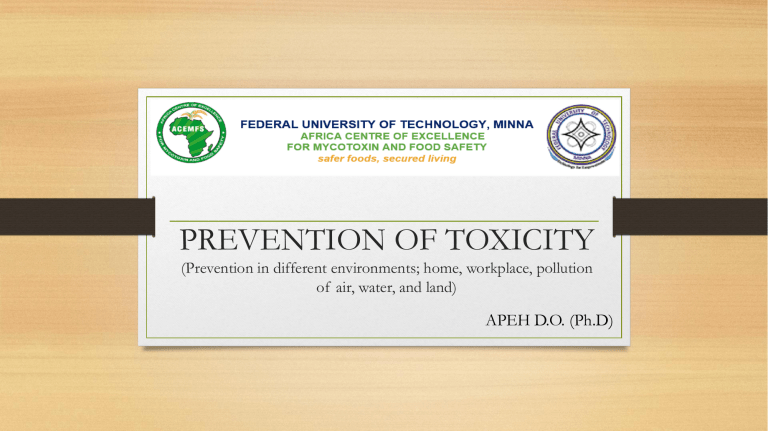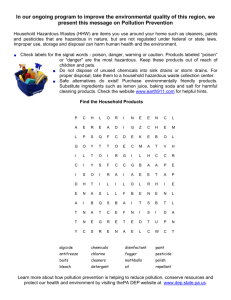
PREVENTION OF TOXICITY (Prevention in different environments; home, workplace, pollution of air, water, and land) APEH D.O. (Ph.D) Poison • Poison, in biochemistry, a substance, natural or synthetic, that causes damage to living tissues and has an injurious or fatal effect on the body, whether it is ingested, inhaled, or absorbed or injected through the skin KEY CONCEPTS • Prevention of toxic exposures is concerned with preventing chemicals of synthetic or natural origin from reaching people in amounts or at rates that exceed human tolerance to them. It includes identifying and evaluating the causes of poisonings, making predictions about their frequency, and putting into practice measures intended to mitigate or eliminate future exposures or to reduce the severity of health effects after an exposure. • Prevention of exposure is part of the dynamic process of toxicovigilance, which includes identification and evaluation of toxic risks and phenomena, and communication with the authorities in order to plan and take action TYPES OF POISON PREVENTION • Primary poisons prevention activities intervene before the event, aiming to prevent it from happening, either by controlling the victim’s access to the agent, controlling the action of an agent upon the victim, or controlling or changing hostile environmental factors. • Secondary poisons prevention is the action taken after an exposure has occurred, to prevent the poisoning from progressing to a more serious, irreversible or chronic stage and to restore the victim to his/her former state of health. It includes the initial steps to minimize the effects of the toxic agent, the diagnosis, decontamination and first aid treatment, and specific antidote therapy • Tertiary poisons prevention deals with the diagnosis and treatment of poisoning victims who cannot be treated to full recovery, to prevent death or permanent disability. Legislature: The strongest basis for prevention • Exposure can be restricted by: • • • • • Prevention of manufacture Control of use patterns Control of application techniques Environmental manipulation Education. • Effects can be restricted by: • Prophylactic methods • Therapeutic methods • Education • Medicines • • • • HOME In a cabinet Out of the reach of kids In their original containers Be aware of all medicines in your home and how many pills are left in the containers • Never prepare or give medicine to a child in the dark. • Never tell a child that medicine tastes like candy • Always supervise older kids and make sure they're taking the proper doses HOME • Cleaning Products and Other Household Chemicals • in high cabinet far from reach • out of the reach of kids • in their original containers • Use safety latches for all cabinets • When you're cleaning or using household chemicals, keep a close watch on the bottles or buckets if kids are around • Never put roach powders or rat poison on the floors of your home. Do not use insect sprays on furniture or mattresses • Keep car supplies (antifreeze, windshield washer fluid) and gardening products (fertilizer, bug repellent) out of reach in a securely locked area (in your garage, if you have one). Make sure they're stored according to package instructions. HOME • Alcohol • Don't leave alcoholic drinks where kids can reach them • In their original containers • Keep in cabinets: Use safety latches for all cabinets • Some products around the house have alcohol and need to be kept away from kids: • mouthwash • food extracts, such as vanilla and almond • hand sanitizer • perfume and cologne HOME • • • • Lead Paint Avoid lead paint If you have an older home, have the paint tested for lead. Keep up on toys recalled for using lead paint HOME • General precautions for homes • Ventilation must be ensured • Insecticide treatment; as specified • First aid tools should be handy WORKPLACE • Workplace Poison Prevention To prevent workplace poisoning incidents, take steps such as: • Pre-employment instruction: make clear the hazards involved,how and when to contain spills and how and when to evacuate the area around the spill, locations and use of emergency equipment, showers, eye washes, and the most important procedures should be posted in the work area • Ventilating work areas where hazardous substances are used and stored; enclosing hazardous operations to prevent dangerous vapors from escaping into the air employees breathe • Restricting entry to hazardous areas to authorized, trained, and properly equipped workers • Requiring the use of PPE (Personal Protection Equipment) specifically designed to protect you against the specific hazardous substances employees work with: protective clothing, gloves, gas masks and goggles • Training employees to consult the MSDS (Material Safety Data Sheet) and their supervisor for the proper PPE and work practices for handling hazardous substances WORKPLACE • Workplace Poisons and Workers’ Families • One study found family members had contracted serious illnesses like asbestosis and chronic beryllium disease as a result of workers’ exposures on the job. Other studies have reported illnesses among workers’ family members resulting from exposure to such highly hazardous substances as lead, cadmium, arsenic, mercury, pesticides, and other chemicals. • Hazardous materials can be transported home in several ways: • Dusts and particles on clothes can get into the air in the home as well as clinging to other surfaces. • If workers wash contaminated work clothes with other laundry, those items could become contaminated, too. • Hand tools and other equipment that have had contact with hazardous substances can contaminate whatever they touch— furniture, flooring, a car or truck. • Work-related materials such as bags, rags, or scrap lumber can also be contaminated and spread contamination. • If workers have not carefully decontaminated and removed hazardous substances from hands, hair, or other body parts, they could to spread the contamination to whatever—and whomever—they touch. LAND, WATER & AIR POLLUTION As the World Health Organization (WHO) points out, outdoor air pollution contributes as much as 0.6 to 1.4 percent of the burden of disease in developing regions, and other pollution, such as lead in water, air, and soil, may contribute 0.9 percent (WHO 2002). These numbers may look small, but the contribution from most risk factors other than the "top 10" is within the 0.5 to 1.0 percent range (WHO 2002). LAND POLLUTION Key concerns: • Complex pollution leachate mixtures from mismanaged and uncontrolled dumpsites; includes mercury, arsenic, organic compounds, heavy metals and other hazardous substances • Pesticides and antimicrobial drugs in crop and livestock productions are among pollutants of key concern • Pollution from abandoned industrial sites, armed conflict zones, nuclear power stations, pesticide stockpiles, waste landfills - part of a longer-term legacy LAND POLLUTION sources/causes • • • • • • • • Industrialization Agricultural chemicals Urbanization Landfills and waste Mining Deforestation Nuclear waste Sewage treatment PREVENTION • Proper waste management layout • Recycling and re-use • Encouraging the use of Biodegradable products • Grow more trees WATER • Common Water Pollutants • Heavy metal pollution: Heavy metals top the list of inorganic pollutant with wide range of negative effects on aquatic organisms, plants, and human. Released via industries, mining activities, agricultural activities etc. • Microorganisms: Municipal sewage, agriculture pollution, and water runoff: bacteria (such as Shigella, Escherichia coli, Vibrio, and Salmonella), viruses (such as Norwalk virus and rotaviruses), and protozoans (such as Entamoeba, Giardia, and Cryptosporidium) may be found in water. • Organic pollutants: Organic pollutants are very wide in variety with a huge range of toxicity. Among the list of organic pollutants that has been of great threat to aquatic organisms, plants, and humans are dyes, pesticides, plant and animal pharmaceuticals, personal care products wastes as well as petroleum organic pollutants. WATER • Prevention of Toxicity from water source • Minimize or avoid the use of chemicals for industrial, agricultural, and domestic purposes. • Adapt practices such as organic farming and integrated pest management to protect waterways (Scheierling 1995). • Chemical contamination of waterways from industrial emissions could be reduced by cleaner production processes (UNEP 2002) • Properly treat hazardous waste, and recycle chemical containers and discarded products containing chemicals to reduce solid waste buildup and leaching of toxic chemicals into waterways. • Comprehensive water treatment plans • A variety of technical solutions are available to filter out chemical waste from industrial processes or otherwise render them harmless. • Changing the pH of wastewater or adding chemicals that flocculate the toxic chemicals so that they settle in sedimentation ponds are common methods. The same principle can be used at the individual household level. • One example is the use of iron chips to filter out arsenic from contaminated well water in Bangladeshi households (Kinniburgh and Smedley 2001). Minimizing Environmental AIR Pollution • • • • • • • Increased use of public transports Turn off the lights when not in use Recycle and Reuse Reduction of forest fires and smoking Use filters for chimneys Avoid using of products with chemicals where possible Implement Afforestation Minimizing AIR Pollution at Home • Avoid smoking indoors (but quitting smoking is the best answer for overall health). • Make sure your gas stove is well-ventilated. • Remove carpeting if possible. • Use a dehumidifier and/or air conditioner to reduce moisture. • Keep trash covered to avoid attracting pests. • Have car emissions tested regularly. • Minimize air freshener use. • Use carbon monoxide detectors. • Dust surfaces and vacuum frequently. • Wash bedding weekly in hot water. • Make sure exhaust fans are functioning in your bathrooms and kitchen AIR – CO Poisoning • Every year, at least 430 people die in the U.S. from accidental CO poisoning. Approximately 50,000 people in the U.S. visit the emergency department each year due to accidental CO poisoning. • • The most common symptoms of CO poisoning are headache, dizziness, weakness, nausea, vomiting, chest pain, and confusion. CO Poisoning Prevention Tips • Check or change the batteries in your CO detector every six months. If you don’t have a battery-powered or battery back-up CO detector, buy one soon. • • • • Have your heating system, water heater and any other gas, oil, or coal burning appliances serviced by a qualified technician every year. • • Never use a charcoal grill, hibachi, lantern, or portable camping stove inside a home, tent, or camper. • If you suspect CO poisoning Keep vents and flues free of debris. Debris can block ventilation lines. Never leave the motor running in a vehicle parked in an enclosed or partially enclosed space, such as a garage. Never run a motor vehicle, generator, pressure washer, or any gasoline-powered engine less than 20 feet from an open window, door, or vent where exhaust can vent into an enclosed area. Never run a generator, pressure washer, or any gasoline-powered engine inside a basement, garage, or other enclosed structure, even if the doors or windows are open. •Thank you

